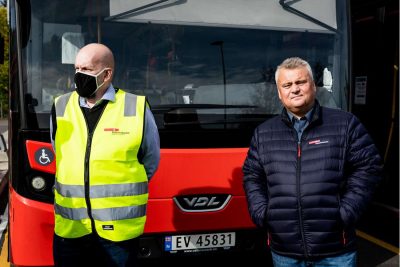More than 8,000 bus drivers are now on strike from Finnmark in the north to Oslo in the south. The strike that began in the greater metropolitan Oslo area last week spread over the weekend, with the drivers demanding salaries that would bring them closer up to what other industrial colleagues earn.

“The bus drivers work extremely demanding shifts, their pay is low, their safety is under threat and we’re worried about the future for these important jobs,” declared Jørn Eggum, leader of the large trade union federation Fellesforbundet.
The strike by Eggum’s federation along with Fagforbundet, Norsk Jernbaneforbund and Yrkestrafikkforbundet (YTF) began when around 4,500 bus drivers in Oslo and Viken counties were called off the job last weekend. They all claim that employers’ organization NHO Transport has broken earlier promises over the past 13 years to bring bus drivers’ salaries in line with colleagues in other areas of industry and public transport.
Newspaper Klassekampen reported late last week, for example, how a tram driver in Oslo can earn NOK 67,000 more per year than a bus driver in Oslo. Thomas Stave, who has driven trams for Oslo Sporveier for the past 10 years, earns around NOK 500,000 a year. Marit Sauge, a bus driver in Oslo for Unibuss who’s also the leader of the bus union in Fagforbundet, earns NOK 433,000. Unibuss is one of the private bus companies that operates bus traffic after winning a contract from the City of Oslo.
‘Systematic differences’
Stave and Sauge point to “systematic differences” in salaries and working conditions between the city-owned tram system and the bus service that’s put out to bid. A tram or metro driver with 10 years of seniority in Oslo has base pay of NOK 444,600 but also earns 40 percent more when working shifts after 5pm.
The striking bus drivers with 10 years of seniority have base pay of NOK 405,660 (USD 42,600) and earn 25 percent more for shifts after 7pm. Sauge told Klassekampen there’s a clear disadvantage for workers when public sector contracts are put out to bid.
The striking drivers are most unhappy, however, over how the pay gap has continued to widen over the years. In 2015, they claim, bus drivers earned 93.9 percent of the average industrial worker. In 2019, they earned 91.9 percent.
Public support
They’ve been gaining public support since the strike spread to Vestland, Trøndelag, Rogaland, Agder, Møre og Romsdal, Nordland and Finnmark on Saturday. Nearly 8,500 bus drivers are on strike, now in areas where there are few if any public transport alternatives to the bus. The strike has also halted school buses, with no new negotiations underway.
“I’ve been told (by passengers) to stand firm, and we’re sorry about the consequences this is having for folks,” Marit Engeseth, among strikers in Bergen, told state broadcaster NRK. Sigrid Døving Bjerke, a 20-year-old county leader for the Labour Party’s youth group in Innland County, thanked the strikers in a column in newspaper Aftenposten on Saturday, claiming such strikes are what have led to the “better worklife” in Norway “that many of us take for granted today.”
“The bus drivers are among the pandemic’s heroes and have kept communities going in recent months,” Siavash Mobasheri of the Reds Party in Oslo told Klassekampen. Union leaders want negotiations to resume, but there haven’t been any signs of NHO Transport coming back to the bargaining table.
‘Sorry’
“We’re sorry that it wasn’t possible to come to an agreement, not least out of consideration for passengers,” stated Jon Stordrange, managing director of NHO Transport.
He contended, however, that public transport operations are in the midst of a “difficult and uncertain situation,” after months of lower ridership and reduced fare revenue during the Corona pandemic. That, he claims, has led to lower public sector budgets, reduced operations and, he warned, possible layoffs.
Most cities and counties, however, had been boosting their public transport options, not least as part of climate- and emissions reductions measures, and are expected to resume such expansion when the pandemic eases.
NewsInEnglish.no/Nina Berglund

